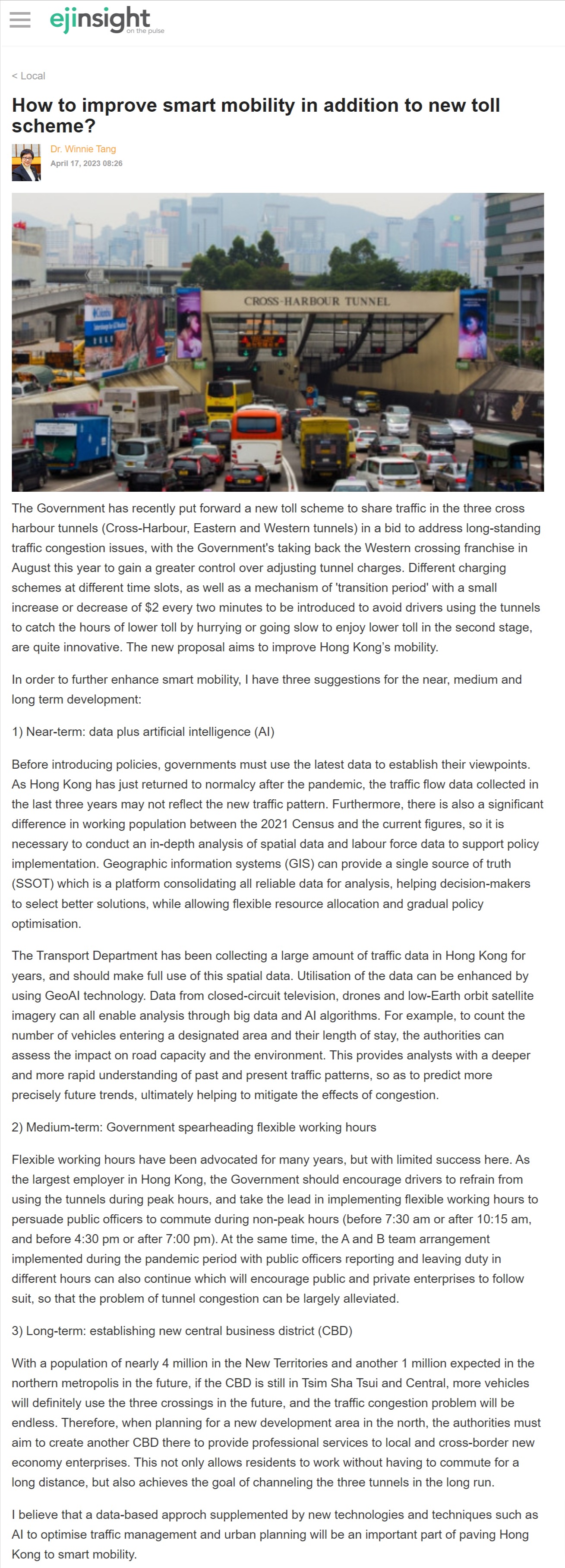網上版請按此

How to improve smart mobility in addition to new toll scheme?
The Government has recently put forward a new toll scheme to share traffic in the three cross harbour tunnels (Cross-Harbour, Eastern and Western tunnels) in a bid to address long-standing traffic congestion issues, with the Government's taking back the Western crossing franchise in August this year to gain a greater control over adjusting tunnel charges. Different charging schemes at different time slots, as well as a mechanism of 'transition period' with a small increase or decrease of $2 every two minutes to be introduced to avoid drivers using the tunnels to catch the hours of lower toll by hurrying or going slow to enjoy lower toll in the second stage, are quite innovative. The new proposal aims to improve Hong Kong's mobility.
In order to further enhance smart mobility, I have three suggestions for the near, medium and long term development:
1) Near-term: data plus artificial intelligence (AI)
Before introducing policies, governments must use the latest data to establish their viewpoints. As Hong Kong has just returned to normalcy after the pandemic, the traffic flow data collected in the last three years may not reflect the new traffic pattern. Furthermore, there is also a significant difference in working population between the 2021 Census and the current figures, so it is necessary to conduct an in-depth analysis of spatial data and labour force data to support policy implementation. Geographic information systems (GIS) can provide a single source of truth (SSOT) which is a platform consolidating all reliable data for analysis, helping decision-makers to select better solutions, while allowing flexible resource allocation and gradual policy optimisation.
The Transport Department has been collecting a large amount of traffic data in Hong Kong for years, and should make full use of this spatial data. Utilisation of the data can be enhanced by using GeoAI technology. Data from closed-circuit television, drones and low-Earth orbit satellite imagery can all enable analysis through big data and AI algorithms. For example, to count the number of vehicles entering a designated area and their length of stay, the authorities can assess the impact on road capacity and the environment. This provides analysts with a deeper and more rapid understanding of past and present traffic patterns, so as to predict more precisely future trends, ultimately helping to mitigate the effects of congestion.
2) Medium-term: Government spearheading flexible working hours
Flexible working hours have been advocated for many years, but with limited success here. As the largest employer in Hong Kong, the Government should encourage drivers to refrain from using the tunnels during peak hours, and take the lead in implementing flexible working hours to persuade public officers to commute during non-peak hours (before 7:30 am or after 10:15 am, and before 4:30 pm or after 7:00 pm). At the same time, the A and B team arrangement implemented during the pandemic period with public officers reporting and leaving duty in different hours can also continue which will encourage public and private enterprises to follow suit, so that the problem of tunnel congestion can be largely alleviated.
3) Long-term: establishing new central business district (CBD)
With a population of nearly 4 million in the New Territories and another 1 million expected in the northern metropolis in the future, if the CBD is still in Tsim Sha Tsui and Central, more vehicles will definitely use the three crossings in the future, and the traffic congestion problem will be endless. Therefore, when planning for a new development area in the north, the authorities must aim to create another CBD there to provide professional services to local and cross-border new economy enterprises. This not only allows residents to work without having to commute for a long distance, but also achieves the goal of channeling the three tunnels in the long run.
I believe that a data-based approch supplemented by new technologies and techniques such as AI to optimise traffic management and urban planning will be an important part of paving Hong Kong to smart mobility.
Dr. Winnie Tang
Adjunct Professor, Department of Computer Science, Faculty of Engineering; Department of Geography, Faculty of Social Sciences; and Faculty of Architecture, The University of Hong Kong